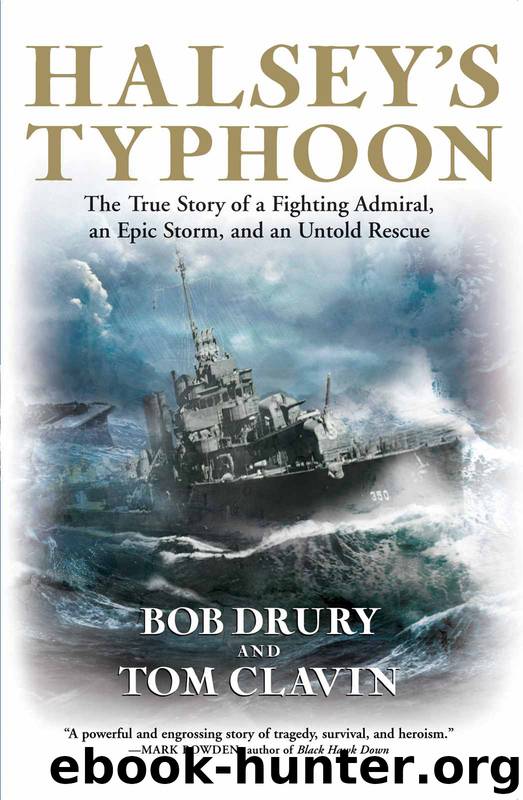Halsey's Typhoon: The True Story of a Fighting Admiral, an Epic Storm, and an Untold Rescue by Bob Drury & Tom Clavin

Author:Bob Drury & Tom Clavin [Drury, Bob]
Language: eng
Format: epub
Publisher: Grove/Atlantic, Inc.
Published: 2007-12-01T00:00:00+00:00
But Ingersoll would not let go so easily. He directed Ford to lead a team down to the hangar deck, evacuate the wounded, and try to douse the flames. Before Ford could comply, Ingersoll received an order from Halsey relayed via Admiral Montgomery. Halsey, informed of the Monterey’s plight, had decided to abandon her. Ingersoll was told that two cruisers and several destroyers had been directed to steam abreast of his carrier to rescue survivors, more of a pipe dream than a practical reality in these seas.
Ingersoll mulled Halsey’s directive for a moment, then scanned the raging ocean. He turned to look into the faces of the men huddled about him in the pilothouse. Each, including Ford, was a pale silhouette in the dark. “No,” he said. “We can fix this.”
He radioed Montgomery to advise Admiral Halsey of his decision. There was precedent to Ingersoll’s resolution. War planners in Washington had long suspected, if not exactly articulated, that in the early stages of World War II too many American vessels had been lost due to hasty orders from panicky captains to abandon ship. The Navy Department was clearly displeased. As a pointed reminder, the cover line on the department’s 1944 Damage Control Manual was a none-too-subtle “Don’t Give Up the Ship.”
Now, with a nod from Ingersoll, Ford donned a gas mask and led a fire brigade below. Aircraft gas tanks exploded as hose handlers slid across the burning hangar deck. Into this furnace Ford took his men, his first order of business to carry out the unconscious survivors. As one firefighter was overcome by smoke, or burned by the shooting flames, another sailor took his place.
At 9:41 A.M. the Monterey’s Captain Ingersoll radioed Admiral Montgomery, “Have fire under control. Prefer to lie to until we can make formation speed.”
In near-miraculous fashion, one by one the carrier’s boilers were brought back on line. Of her 34 aircraft, she’d lost 18 burned in the hangar deck or blown off the flight deck, with the remaining 16 seriously damaged.
Thirty years later, after Lt. (j.g.) Jerry Ford became president of the United States, he wrote of that morning, “I remembered that fire at the height of the typhoon, and I considered it a marvelous metaphor for the ship of state.”
Aboard too many of Halsey’s ships on that December day in 1944, however, reality was outpacing metaphor. About the same time that Halsey received word of Ingersoll’s refusal to abandon the Monterey, the carrier USS Cowpens reported fire raging across her hangar deck and was saved only when the wind and water tore off the deck’s heavy steel roller door as if it were Styrofoam and the sea flooded in knee-deep, dousing the flames. On the USS Altamaha, a bomb truck snapped its fastening cable and collided with a fighter plane. The aircraft’s fuel tank detonated, igniting planes on either side of it. The ship’s fire extinguisher system drowned the fire, but the torrents of water gushing down her fractured ventilator shaft flooded her lower compartments.
Download
This site does not store any files on its server. We only index and link to content provided by other sites. Please contact the content providers to delete copyright contents if any and email us, we'll remove relevant links or contents immediately.
| Africa | Americas |
| Arctic & Antarctica | Asia |
| Australia & Oceania | Europe |
| Middle East | Russia |
| United States | World |
| Ancient Civilizations | Military |
| Historical Study & Educational Resources |
Flight by Elephant(1480)
The Rise and Fall of the Third Reich: A History of Nazi Germany by William L. Shirer(1381)
Unbroken: A World War II Story of Survival, Resilience, and Redemption by Hillenbrand Laura(1099)
German submarine U-1105 'Black Panther' by Aaron Stephan Hamilton(1018)
Last Hope Island by Lynne Olson(933)
A Bridge Too Far by Cornelius Ryan(927)
War by Unknown(904)
The Victors - Eisenhower and His Boys The Men of World War II by Stephen E. Ambrose(900)
The Guns at Last Light: The War in Western Europe, 1944-1945 by Rick Atkinson(887)
Rogue Heroes: The History of the SAS, Britain's Secret Special Forces Unit That Sabotaged the Nazis and Changed the Nature of War by Ben Macintyre(882)
0060740124.(F4) by Robert W. Walker(871)
The Hitler Options: Alternate Decisions of World War II by Kenneth Macksey(865)
The Railway Man by Eric Lomax(846)
All the Gallant Men by Donald Stratton(814)
Hitler's Vikings by Jonathan Trigg(806)
A Tragedy of Democracy by Greg Robinson(800)
Churchill's Secret War by Madhusree Mukerjee(796)
Hitler's Armies by Chris McNab(781)
We Die Alone: A WWII Epic of Escape and Endurance by David Howarth & Stephen E. Ambrose(744)
